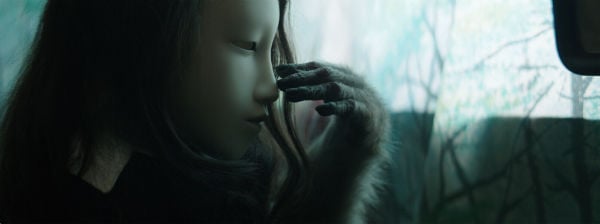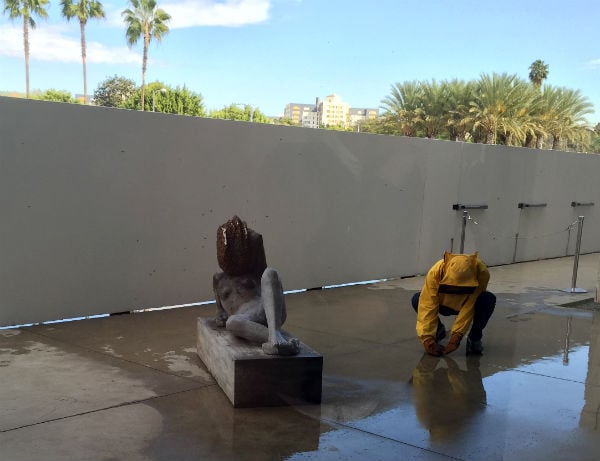Opinion
Is Pierre Huyghe the World’s Most Opaque Popular Artist? Ben Davis Sizes Up His LACMA Show
The retrospective is a "relational aesthetics" theme park for art nerds.
The retrospective is a "relational aesthetics" theme park for art nerds.
Ben Davis

“I’m interested in the different formats in which the Disney narrative moves through the characters, the films, the theme parks,” French artist Pierre Huyghe (b. 1962) once said in an interview with his fellow guru of participatory art, Rirkrit Tiravanija. “The whole operation was brilliant… After that, of course, he embedded certain moral values that are frightening.” Indeed, throughout his career, the slickness of the entertainment industry in general, and Walt Disney in particular, have served Huyghe as key reference points, albeit negative ones. There is some significance, then, in bringing his critically acclaimed mid-career retrospective to Disney’s home turf, Los Angeles, where it has just opened at LACMA.
The resulting installation of 50 projects from throughout Huyghe’s career—full of live creatures, art-historical in-jokes, and difficult moments of offbeat beauty—does not, above all, feel like a retrospective, which is of course deliberate. The idea of “challenging the form of the retrospective itself” is fast becoming its own kind of contemporary-art cliché, about as shocking as the fact that every Disney child star must eventually exhibitionistically shred the Disney image en route to an adult career. Still, Huyghe’s spin on the anti-retrospective thing is not without its merits, with the selection of works installed as a dizzyingly interconnected installation rather than a linear essay.
In the low-lit galleries of LACMA’s Resnick Pavilion, videos loop and play off one another—there is always something springing to life as something else is going dark. The walls form a series of vectors intersecting in odd ways, with unexpected objects in nooks and crannies. Every so often, the show will literally come to life: a dog with a pink-dyed leg trots through; a man wearing a face-obscuring mask studded with LED lights strolls casually past; a writer sets up shop at a table, patting away at a keyboard, typing out observations about what is happening in the galleries that are then tacked to the wall.
![Participant wearing Player (2010) with Human (2012) [the dog], alongside Zoodram 5 (2011), during the opening of "Pierre Huyghe" at LACMA](https://news.artnet.com/app/news-upload/2014/11/lacma-pierre-huyghe-dog-and-man.jpg)
Participant wearing Player (2010) with Human (2012) [the dog], alongside Zoodram 5 (2011), during the opening of “Pierre Huyghe” at LACMA
Photo: Ben Davis
There are genuine crowd-pleasers: The central gallery is held by a wall-filling projection of Untitled (Human Mask) (2014), a new video inspired by news reports about a restaurant employing a small monkey as a waiter in post-Fukushima Japan. The film is largely plotless, simply capturing the animal wearing an ivory-skinned human mask as it scuttles around a forlorn, seemingly post-disaster restaurant, cowering from the sound of rain or going through the motions of what looks very much like human prayer. The work is weird and awesome, inspiring both pathos and a deep, uncanny shiver.

Pierre Huyghe, Film still from Untitled (Human Mask) (2014)
Courtesy: Pierre Huyghe, Marianne Goodman, Hauser & Wirth, Esther Schipper, and Anna Lena Films
Elsewhere, the kids will love Huyghe’s sculptures using teeming aquaria, the best being Zoodram 5 (2011), which features an utterly charming hermit crab who has taken up residence in a replica of a totemic Constantin Brancusi sculpture. And as a climax in the exterior courtyard at the end of the show, Huyghe has installed Untilled (Liegender Frauenakt) (2012) (previously seen at Documenta 2012, where it was a particular hit), a statue of a recumbent female nude with an active beehive for a head. This is a memorably novel sculptural image as well as a brute force way to insert some danger back into the art-going experience.

Pierre Huyghe’s Untilled (Liegender Frauenakt) (2012), with beekeeper, at LACMA
Photo: Ben Davis
Yet, because this maze-like show provides no chronological or thematic narrative to hold onto, and scant contextual information about anything, for every crowd-pleasing moment, there are literally dozens of moments that even someone who is somewhat familiar with Huyghe’s work will have no idea what to make of. One example of many: Unrealized (Mies Cuba Gets Cold) (2000) (2011), a fragmentary collage hung in a corner space. It centers on the image of a boxy glass museum building filled with tropical foliage. It was inspired by the realization that Berlin’s Mies van der Rohe-designed Neue Nationalgalerie was based on a thwarted design for Bacardi’s headquarters in Cuba. Wouldn’t it be funny, Huyghe was asking, to fill famed Teutonic museum with a tropical scene representing this origin? The work’s interest is drastically expanded with that simple reference. But there is no obvious way to get at it.
Huyghe will be forever associated with the term “relational aesthetics,” critic Nicolas Bourriaud’s name for an approach to art shared by mid-90s artists who incorporated unpredictable processes and live participation into their work. The term’s success is partly due to the fact that Bourriaud did something that is justifiably unfashionable: He promised political righteousness for an artistic style. Public space had become so over-regulated, so bound by corporate messaging and bureaucratic dictates, he argued, that there was something liberatory about works that used the gallery to open up spaces for the willfully unexpected. This notion has been endlessly critiqued, and turned out to be more a way to feed the art world’s need for glorified theme parties than anything else, but its convictions still frame Huyghe’s modus operandi.
“I’m less interested in dramatic, linear processes where there’s a planned protocol. I’m more interested in open scenarios,” Huyghe told Doug Aitken in Bomb, contrasting this approach with Disney films that seem “too efficient, too seamless.” The tendentious shapelessness of the LACMA exhibition represents how more recently the artist has come to apply this anti-efficiency argument about mass media to the museum: “Exhibitions revolve more and more around the need to address a target public,” he told the Art Newspaper. “A museum’s education department needs visitors to understand, otherwise they won’t be happy and won’t come back.” Huyghe later added, “I don’t want to exhibit something to someone any more. I want to do the reverse: I want to exhibit someone to something.”
As a thing to rebel against, the idea that you might possibly have a body of achievements, and that a major museum might want to communicate them to the public seems to me to fall into the category of #SuccessfulArtistProblems. While museums are indeed more and more corporate, defying the conventions of a Disneyfied entertainment industry and defying the conventions of fine art are two very different things: a Hollywood blockbuster is trying to cram as much crowd-pleasing stuff into a tidy package as possible; museums are trying to take some very untidy things—cultural objects that might seem alienating or uninviting—and give the uninitiated a way in, so that they might begin to enjoy themselves.
The conflation of the two gives this survey of Huyghe’s semi-surrealist oeuvre its peculiar texture, somewhere between an adult theme park and that dream where you show up for the final exam but realize you haven’t studied. He wants to free up his audience for the unexpected, liberating them from the dreary aggressions of culture that tells you how to think or feel. But by pushing so hard in the other direction, he may end up giving the audience exactly what it expects from contemporary art: hermetic weirdness, served extra hermetic.
There are parts where the show feels unusual in its direct experiential appeal. There are others where it feels unusually esoteric. That unlikely bipolarity points to just what an odd creature Huyghe is, but also makes the rare moments where he actually pulls off the trick of being both at once seem all the more remarkable.
“Pierre Huyghe” is on view at the Los Angeles County Museum of Art, through February 22, 2015.